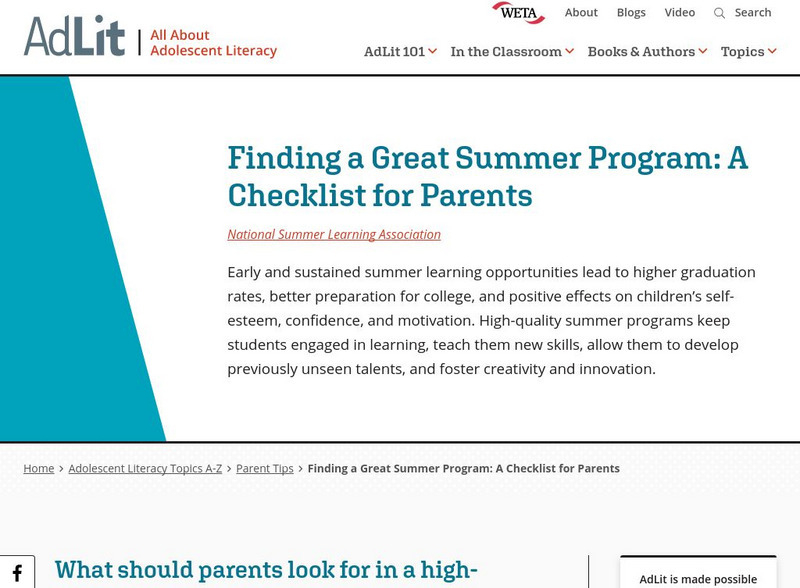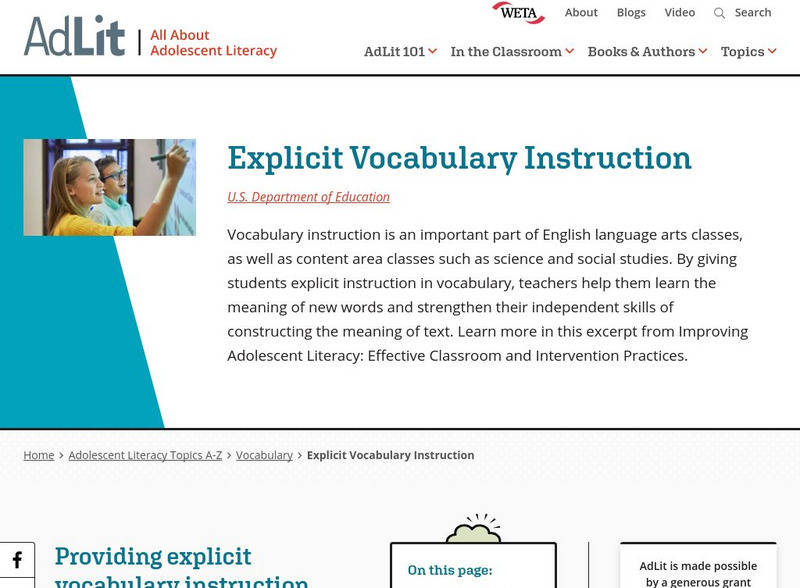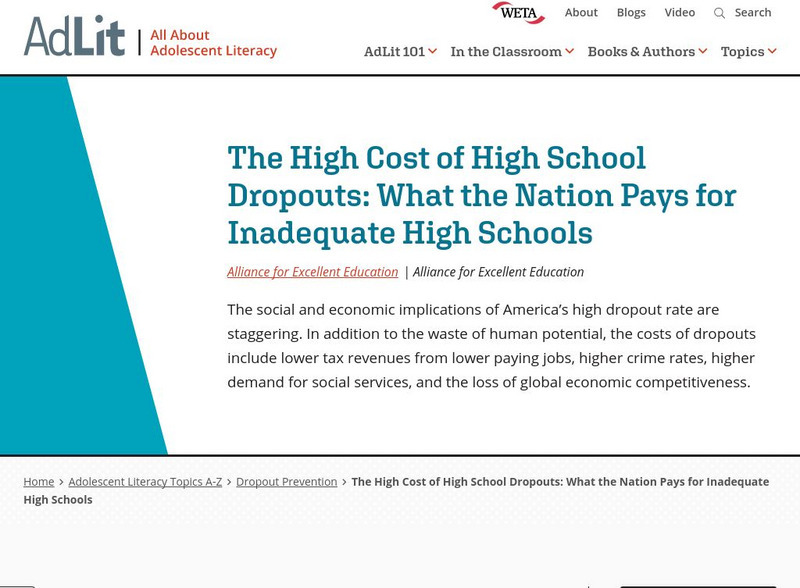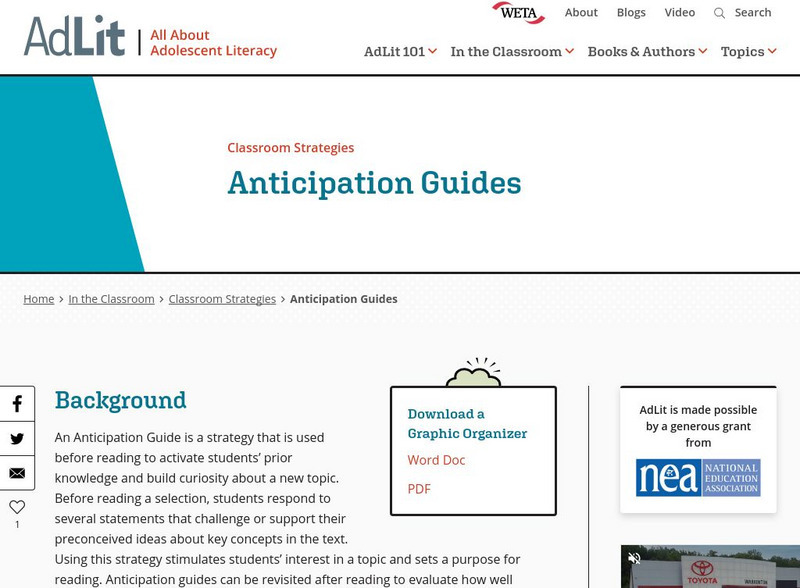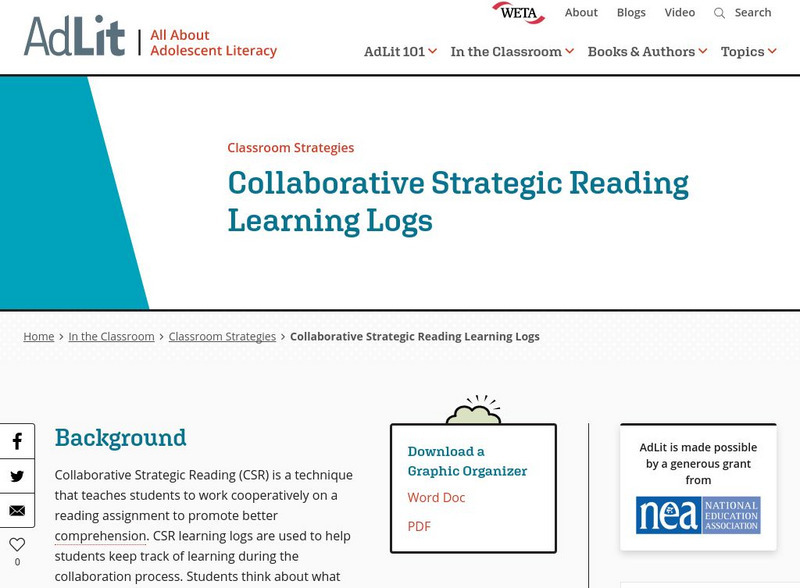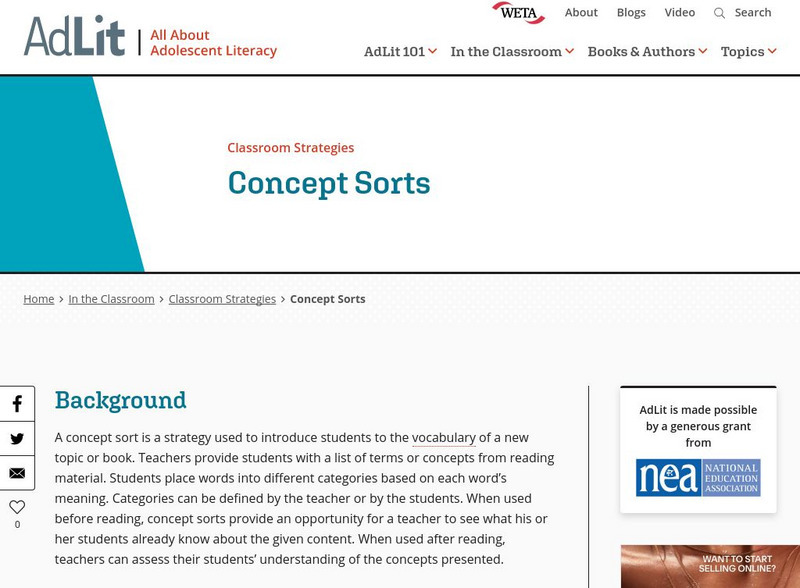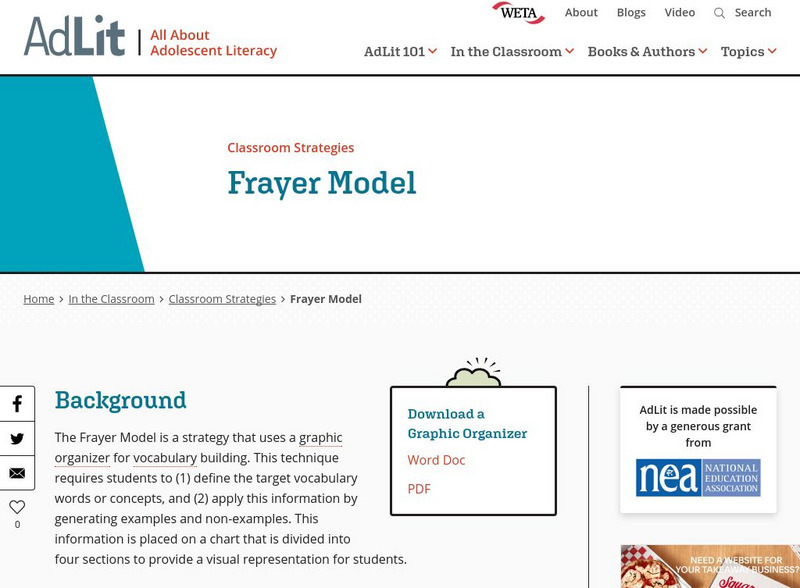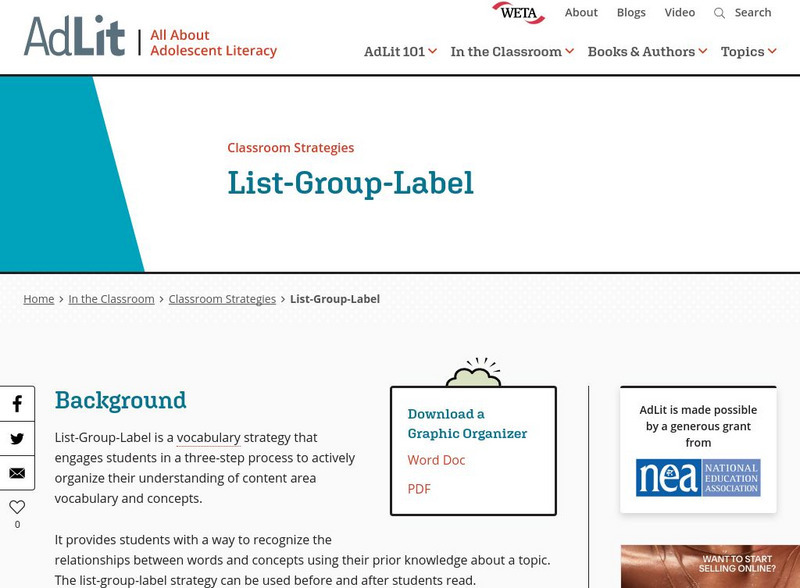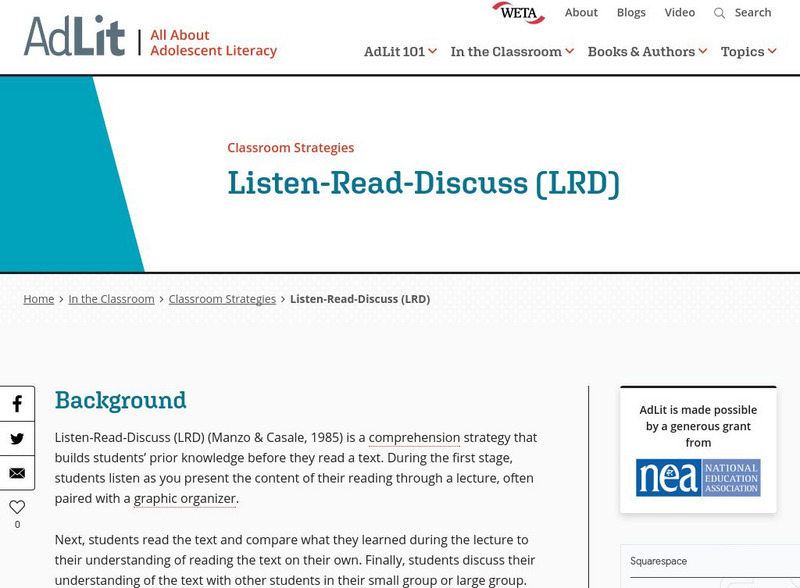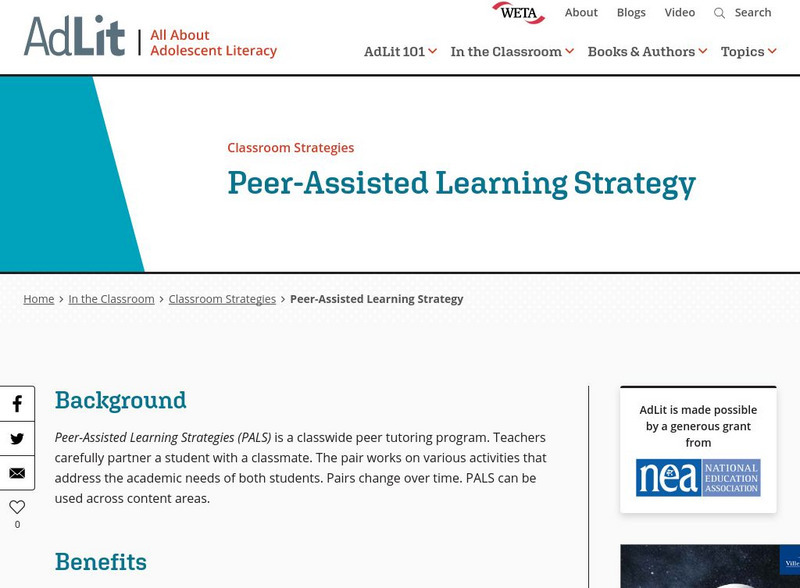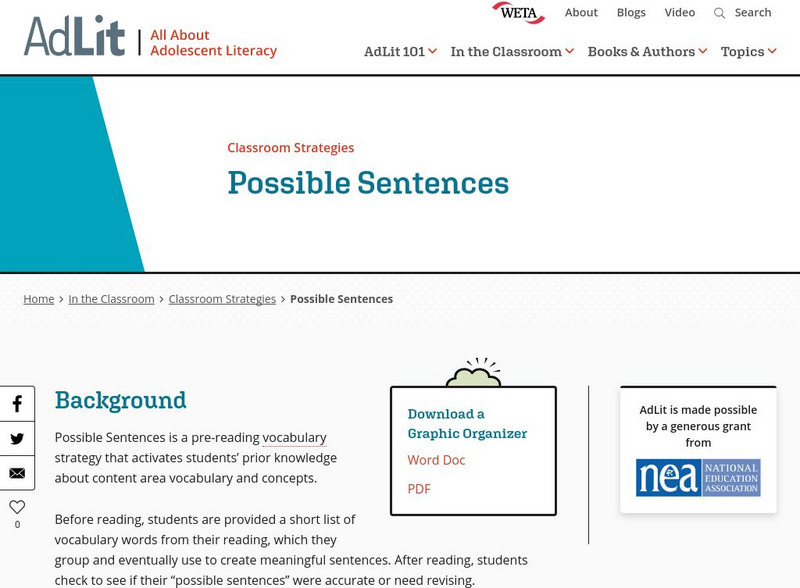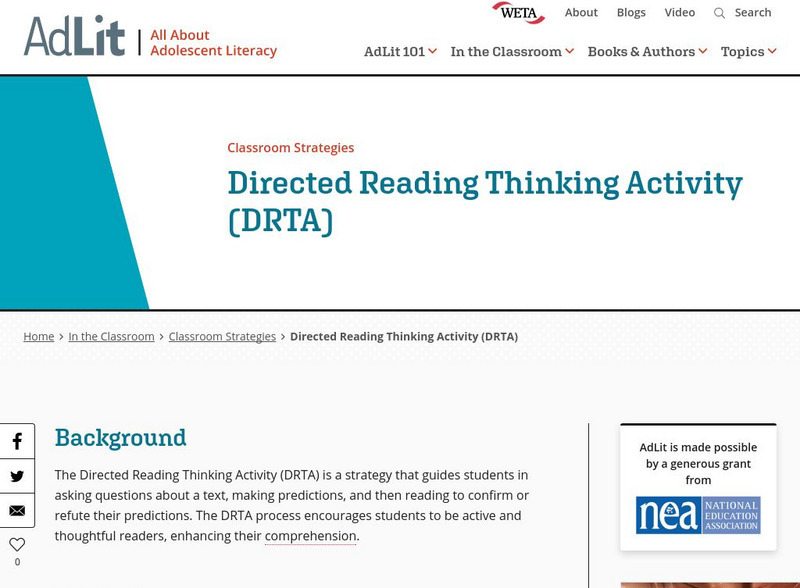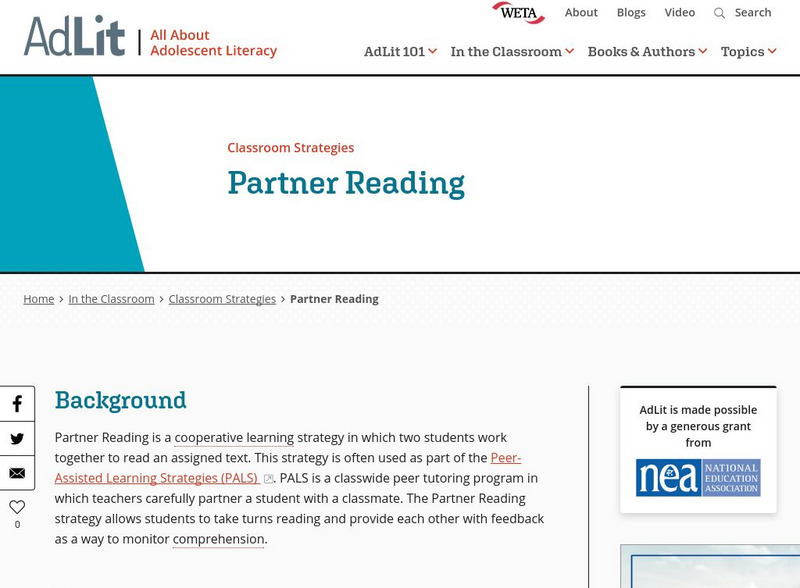AdLit
Ad lit.org: Classroom Strategies: Story Maps
Story Maps are used for teaching students to work with story structure for better comprehension. This technique uses visual representations to help students organize important elements of a story. Students learn to summarize the main...
AdLit
Ad lit.org: Classroom Strategies: Sq3 R: Survey Question Read Recite Review
SQ3R is a comprehension strategy that helps students think about the text they are reading while they're reading. Often categorized as a study strategy, SQ3R helps students "get it" the first time they read a text by teaching students...
AdLit
Ad lit.org: Multiple Texts: Multiple Opportunities for Teaching and Learning
Engaging all students in a themed study or unit is a challenge that teachers can resolve by using materials that match students' independent or instructional reading levels (Robb 1994, 2000). When students face textbooks that are above...
AdLit
Ad lit.org: Helping Equip Teachers to Answer Questions on College Knowledge
In a Stanford University study, a majority of high school students reported speaking with a teacher at least once about college admissions requirements, but teachers reported receiving very little information to answer their students'...
AdLit
Ad lit.org: Making Writing Instruction a Priority in Middle and High Schools
Sometimes writing is seen as the flip side of reading, and it is assumed that students who are proficient readers will naturally be proficient writers. While reading and writing are complementary skills, students do not become skilled...
AdLit
Ad lit.org: Finding a Great Summer Program: A Checklist for Parents
Early and sustained summer learning opportunities lead to higher graduation rates, better preparation for college, and positive effects on children's self-esteem, confidence, and motivation. High-quality summer programs keep students...
AdLit
Ad lit.org: Explicit Vocabulary Instruction
Vocabulary instruction is an important part of reading and language arts classes, as well as content-area classes such as science and social studies. By giving students explicit instruction in vocabulary, teachers help them learn the...
AdLit
Ad lit.org: The High Cost of High School Dropouts: What the Nation Pays
The social and economic implications of America's high dropout rate are staggering. In addition to the waste of human potential, the costs of dropouts include lower tax revenues from lower paying jobs, higher crime rates, higher demand...
AdLit
Ad lit.org: Seven Strategies to Teach Students Text Comprehension
Comprehension strategies are conscious plans - sets of steps that good readers use to make sense of text. Comprehension strategy instruction helps students become purposeful, active readers who are in control of their own reading...
AdLit
Ad lit.org: Effective Reading Programs Grades 6 12: A Best Evidence Synthesis
Many reading programs claim to boost student performance, but how is that measured? Johns Hopkins University examined more than 200 published studies to create this quick guide to programs.
AdLit
Ad lit.org: Teaching Writing to Diverse Student Populations
Writing is a complex operation requiring knowledge of text structure, syntax, vocabulary, and topic, and sensitivity to audience needs; so it is not surprising that many teens find writing challenging. This article identifies the...
AdLit
Ad lit.org: Classroom Strategies: Anticipation Guides
An Anticipation Guide is a strategy that is used before reading to activate students' prior knowledge and build curiosity about a new topic. Before reading a selection, students respond to several statements that challenge or support...
AdLit
Ad lit.org: Classroom Strategies: Collaborative Strategic Reading Learning Logs
Collaborative Strategic Reading (CSR) is a technique that teaches students to work cooperatively on a reading assignment to promote better comprehension. CSR learning logs are used to help students keep track of learning during the...
AdLit
Ad lit.org: Classroom Strategies: Concept Sorts
A concept sort is a strategy used to introduce students to the vocabulary of a new topic or book. Teachers provide students with a list of terms or concepts from reading material. Students place words into different categories based on...
AdLit
Ad lit.org: Classroom Strategies: First Lines
First Lines is a strategy in which students read the beginning sentences from assigned readings and make predictions about the content of what they're about to read. This pre-reading technique helps students focus their attention on what...
AdLit
Ad lit.org: Classroom Strategies: Frayer Model
The Frayer Model is a strategy that uses a graphic organizer for vocabulary building. This technique requires students to (1) define the target vocabulary words or concepts, and (2) apply this information by generating examples and...
AdLit
Ad lit.org: Classroom Strategies: List Group Label
It provides students with a way to recognize the relationships between words and concepts using their prior knowledge about a topic. The list-group-label strategy can be used before and after students read.
AdLit
Ad lit.org: Classroom Strategies: Listen Read Discuss (Lrd)
Listen-Read-Discuss (LRD) (Manzo & Casale, 1985) is a comprehension strategy that builds students' prior knowledge before they read a text. During the first stage, students listen as you present the content of their reading through a...
AdLit
Ad lit.org: Classroom Strategies: Mnemonics
A mnemonic is an instructional strategy designed to help students improve their memory of important information. This technique connects new learning to prior knowledge through the use of visual and/or acoustic cues. The basic types of...
AdLit
Ad lit.org: Classroom Strategies: Peer Assisted Learning Strategy
Peer-Assisted Learning Strategies (PALS) is a classwide peer tutoring program. Teachers carefully partner a student with a classmate. The pair works on various activities that address the academic needs of both students. Pairs change...
AdLit
Ad lit.org: Classroom Strategies: Possible Sentences
Possible Sentences is a pre-reading vocabulary strategy that activates students' prior knowledge about content area vocabulary and concepts.
AdLit
Ad lit.org: Classroom Strategies: Concept Maps
A concept map help students visualize various connections between words or phrases and a main idea. There are several types of concept maps; some are hierarchical, while others connect information without categorizing ideas.
AdLit
Ad lit.org: Classroom Strategies: Directed Reading Thinking Activity (Drta)
The Directed Reading Thinking Activity (DRTA) is a strategy that guides students in asking questions about a text, making predictions, and then reading to confirm or refute their predictions. The DRTA process encourages students to be...
AdLit
Ad lit.org: Classroom Strategies: Partner Reading
Partner Reading is a cooperative learning strategy in which two students work together to read an assigned text. This strategy is often used as part of the Peer-Assisted Learning Strategies (PALS). PALS is a classwide peer tutoring...





